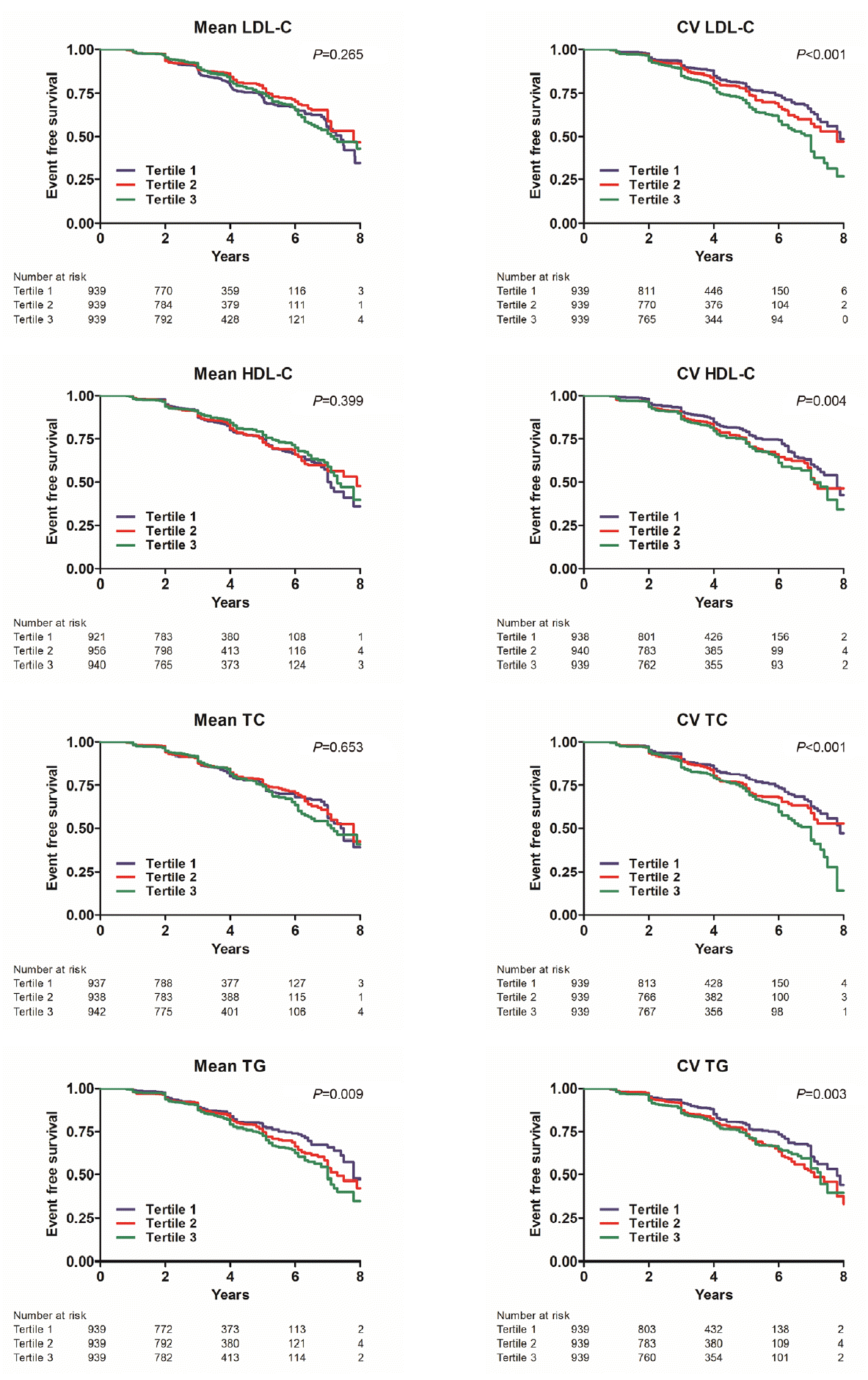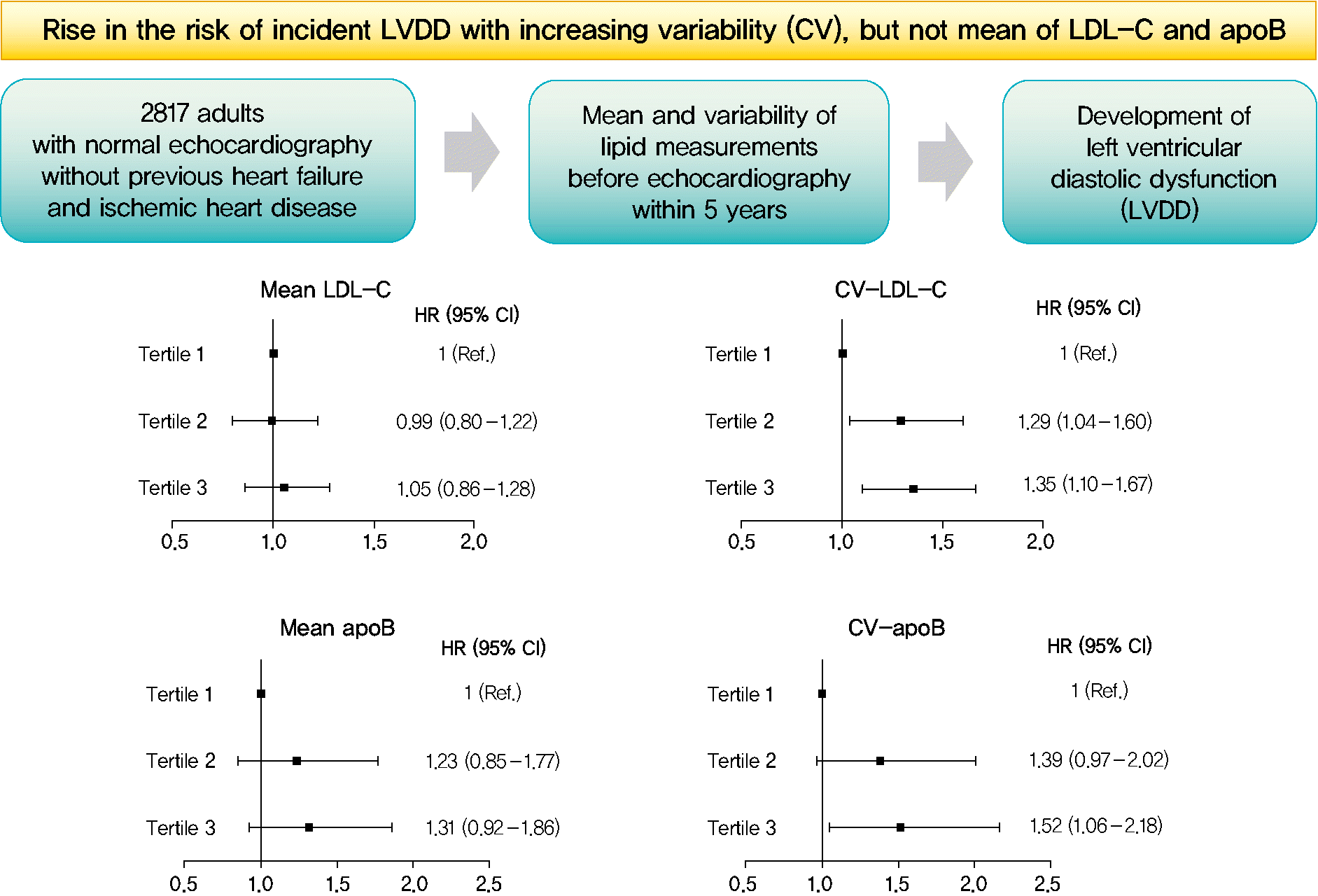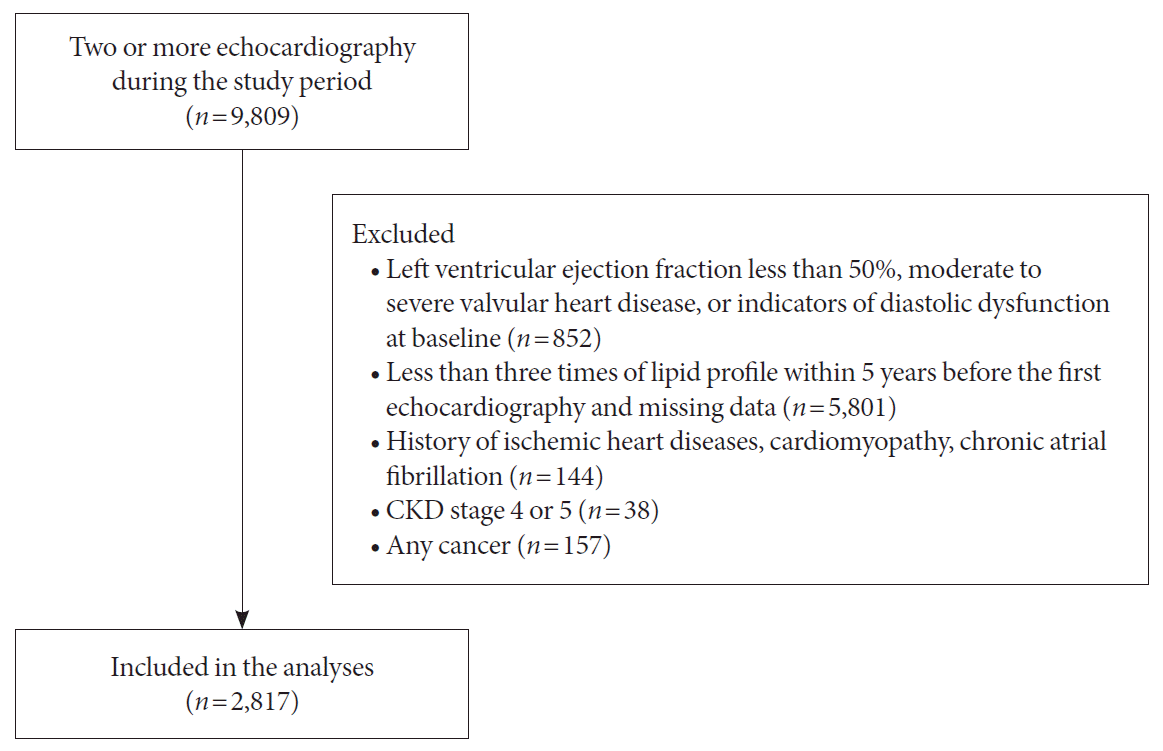INTRODUCTION
METHODS
Study population
Clinical variables, biochemical measurements, and definitions
Definition and measurement of lipid variability
Echocardiographic data, definition of LVDD, and E/e’ change
Statistical analysis
RESULTS
Baseline characteristics and study population
Table 1.
Values are presented as mean±standard deviation or number (%).
LV, left ventricular; DM, diabetes mellitus; FPG, fasting plasma glucose; HbA1c, glycosylated hemoglobin; NT-proBNP, N-terminal fragment of pro-brain natriuretic peptide; hs-CRP, high-sensitivity C-reactive protein; HOMA-IR, homeostasis model assessment of insulin resistance; BMI, body mass index; LDL-C, low-density lipoprotein cholesterol; SD, standard deviation; CV, coefficient of variation; HDL-C, high-density lipoprotein cholesterol; TG, triglyceride; LVEF, left ventricular ejection fraction; E/e’, ratio of early diastolic transmitral flow velocity to early diastolic mitral annular velocity; LAVI, left atrial volume index; LVMI, left ventricular mass index.
Mean and variability of lipid measurements and risk of LVDD
Fig. 2.

Table 2.
| Variable |
Model 1 |
Model 2 |
Model 3 |
Model 4 |
|||||||||
|---|---|---|---|---|---|---|---|---|---|---|---|---|---|
| Tertile 1 | Tertile 2 | Tertile 3 | Tertile 1 | Tertile 2 | Tertile 3 | Tertile 1 | Tertile 2 | Tertile 3 | Tertile 1 | Tertile 2 | Tertile 3 | ||
| LDL-C | |||||||||||||
| Mean | 1 | 0.84 | 0.94 | 1 | 0.91 | 0.99 | 1 | 0.93 | 1.01 | 1 | 0.99 | 1.05 | |
| (reference) | (0.68–1.04) | (0.77–1.14) | (reference) | (0.74–1.12) | (0.81–1.20) | (reference) | (0.76–1.15) | (0.82–1.23) | (reference) | (0.80–1.22) | (0.86–1.28) | ||
| SDa | 1 | 1.19 | 1.61 | 1 | 1.17 | 1.41 | 1 | 1.19 | 1.25 | 1 | 1.25 | 1.27 | |
| (reference) | (0.96–1.47) | (1.32–1.98) | (reference) | (0.95–1.45) | (1.15–1.73) | (reference) | (0.97–1.48) | (1.01–1.54) | (reference) | (1.01–1–54) | (1.03–1.57) | ||
| CVa | 1 | 1.24 | 1.68 | 1 | 1.22 | 1.47 | 1 | 1.23 | 1.33 | 1 | 1.29 | 1.35 | |
| (reference) | (1.00–1.54) | (1.37–2.06) | (reference) | (0.98–1.51) | (1.20–1.80) | (reference) | (1.00–1.53) | (1.08–1.64) | (reference) | (1.04–1.60) | (1.10–1.67) | ||
| HDL-C | |||||||||||||
| Mean | 1 | 0.94 | 0.87 | 1 | 0.88 | 0.75 | 1 | 0.95 | 0.98 | 1 | 0.97 | 0.98 | |
| (reference) | (0.77–1.15) | (0.71–1.07) | (reference) | (0.72–1.08) | (0.61–0.93) | (reference) | (0.78–1.16) | (0.79–1.22) | (reference) | (0.79–1.18) | (0.79–1.23) | ||
| SDa | 1 | 1.1 | 1.31 | 1 | 1.08 | 1.16 | 1 | 1.11 | 1.21 | 1 | 1.16 | 1.24 | |
| (reference) | (0.89–1.35) | (1.07–1.60) | (reference) | (0.88–1.32) | (0.94–1.42) | (reference) | (0.90–1.36) | (0.98–1.50) | (reference) | (0.95–1.43) | (1.00–1.54) | ||
| CVa | 1 | 1.27 | 1.4 | 1 | 1.22 | 1.33 | 1 | 1.16 | 1.21 | 1 | 1.17 | 1.24 | |
| (reference) | (1.04–1.57) | (1.14–1.72) | (reference) | (0.99–1.50) | (1.08–1.63) | (reference) | (0.94–1.42) | (0.98–1.48) | (reference) | (0.96–1.45) | (1.01–1.52) | ||
| TC | |||||||||||||
| Mean | 1 | 0.94 | 1.04 | 1 | 1.03 | 1.08 | 1 | 1.09 | 1.14 | 1 | 1.11 | 1.15 | |
| (reference) | (0.77–1.16) | (0.85–1.27) | (reference) | (0.84–1.27) | (0.89–1.33) | (reference) | (0.88–1.34) | (0.92–1.40) | (reference) | (0.90–1.37) | (0.94–1.42) | ||
| SDa | 1 | 1.33 | 1.51 | 1 | 1.24 | 1.27 | 1 | 1.22 | 1.13 | 1 | 1.24 | 1.15 | |
| (reference) | (1.08–1.64) | (1.23–1.86) | (reference) | (1.00–1.53) | (1.04–1.57) | (reference) | (0.99–1.51) | (0.91–1.40) | (reference) | (1.00–1.53) | (0.93–1.43) | ||
| CVa | 1 | 1.27 | 1.56 | 1 | 1.2 | 1.31 | 1 | 1.24 | 1.18 | 1 | 1.28 | 1.22 | |
| (reference) | (1.03–1.56) | (1.27–1.91) | (reference) | (0.97–1.49) | (1.07–1.61) | (reference) | (1.00–1.53) | (0.96–1.46) | (reference) | (1.03–1.58) | (0.99–1.51) | ||
| TG | |||||||||||||
| Mean | 1 | 1.2 | 1.38 | 1 | 1.23 | 1.5 | 1 | 1.09 | 1.17 | 1 | 1.08 | 1.15 | |
| (reference) | (0.97–1.49) | (1.12–1.70) | (reference) | (0.99–1.52) | (1.22–1.85) | (reference) | (0.88–1.35) | (0.94–1.45) | (reference) | (0.87–1.35) | (0.92–1.42) | ||
| SDa | 1 | 1.17 | 1.35 | 1 | 1.09 | 1.4 | 1 | 0.97 | 1.14 | 1 | 0.97 | 1.13 | |
| (reference) | (0.95–1.44) | (1.10–1.65) | (reference) | (0.88–1.34) | (1.14–1.71) | (reference) | (0.78–1.21) | (0.89–1.45) | (reference) | (0.78–1.20) | (0.89–1.45) | ||
| CVa | 1 | 1.34 | 1.39 | 1 | 1.26 | 1.29 | 1 | 1.22 | 1.26 | 1 | 1.22 | 1.25 | |
| (reference) | (1.09–1.64) | (1.13–1.72) | (reference) | (1.02–1.55) | (1.05–1.59) | (reference) | (0.99–1.50) | (1.03–1.60) | (reference) | (0.99–1.50) | (1.01–1.54) | ||
Values are presented as adjusted hazard ratio (95% confidence interval). Model 1, unadjusted; Model 2, adjusted for age and sex; Model 3, adjusted for covariates in Model 2 plus diabetes, hypertension, and body mass index; Model 4, adjusted for covariates in Model 3 plus baseline E/e’ and glycosylated hemoglobin.
LDL-C, low-density lipoprotein cholesterol; SD, standard deviation; CV, coefficient of variation; HDL-C, high-density lipoprotein cholesterol; TC, total cholesterol; TG, triglyceride.
Subgroup analyses
Table 3.
| Variable |
HR (95% CI) |
P for interaction | ||
|---|---|---|---|---|
| Tertile 1 | Tertile 2 | Tertile 3 | ||
| With statin therapy (n=375) | ||||
| Mean LDL-C | 1 (reference) | 1.22 (0.76–1.95) | 1.39 (0.86–2.24) | |
| SD-LDL-Ca | 1 (reference) | 0.76 (0.49–1.19) | 0.57 (0.35–0.93) | |
| CV-LDL-Ca | 1 (reference) | 0.85 (0.54–1.33) | 0.61 (0.37–1.01) | |
| Without statin therapy (n=2,442) | ||||
| Mean LDL-C | 1 (reference) | 0.94 (0.75–1.20) | 1.12 (0.81–1.28) | 0.604b |
| SD-LDL-Ca | 1 (reference) | 1.21 (0.95–1.54) | 1.38 (1.10–1.74) | 0.086b |
| CV-LDL-Ca | 1 (reference) | 1.26 (1.00–1.61) | 1.36 (1.09–1.72) | 0.079b |
| With statin and/or any lipid modifying agents (n=531) | ||||
| Mean LDL-C | 1 (reference) | 1.17 (0.78–1.74) | 1.30 (0.86–1.94) | |
| SD-LDL-Ca | 1 (reference) | 0.90 (0.59–1.12) | 0.72 (0.48–1.08) | |
| CV-LDL-Ca | 1 (reference) | 0.84 (0.57–1.23) | 0.72 (0.48–1.08) | |
| Without statin and/or any lipid modifying agents (n=2,286) | ||||
| Mean LDL-C | 1 (reference) | 1.01 (0.79–1.30) | 1.05 (0.83–1.34) | 0.984c |
| SD-LDL-Ca | 1 (reference) | 1.21 (0.94–1.55) | 1.31 (1.03–1.67) | 0.160c |
| CV-LDL-Ca | 1 (reference) | 1.26 (0.98–1.62) | 1.27 (1.00–1.62) | 0.199c |




 PDF
PDF Citation
Citation Print
Print





 XML Download
XML Download